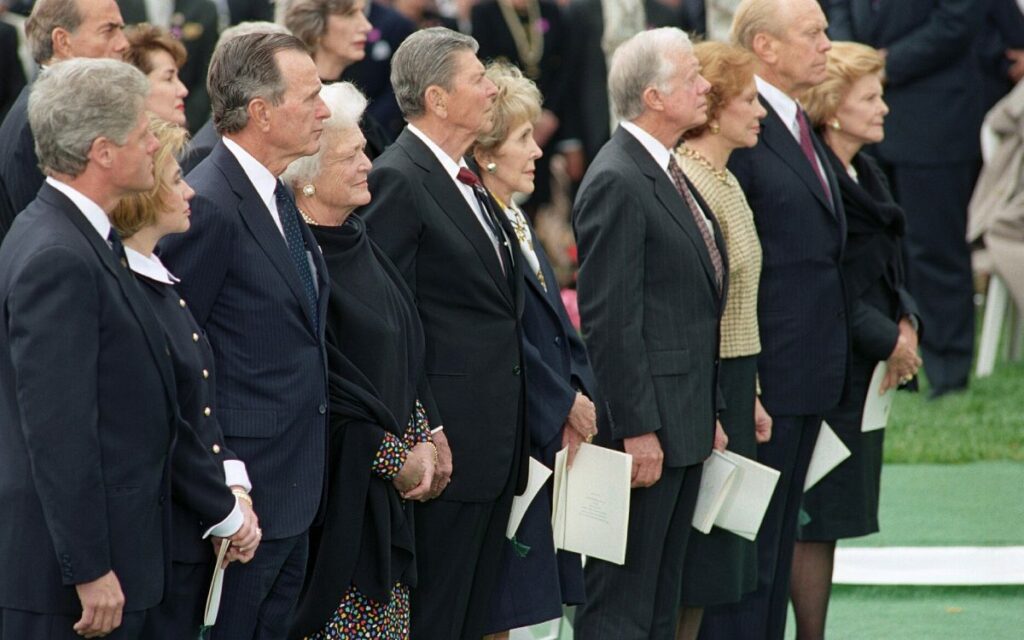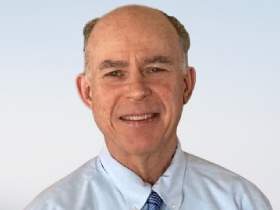
Twenty years after Watergate and upon his death, Nixon seemed to have found a place where he would be judged on his entire life and career. Pictured: Former US presidents and first ladies at President Richard Nixon’s funeral.
After President Richard Nixon resigned in 1974, there were several issues to address. The Imperial presidency, as Arthur M. Schlesinger put it in his 1973 book, saw the power of the presidency becoming uncontrollable and exceeding its constitutional boundaries. The Burger Court trimmed Nixon’s efforts to subvert normal governing practices and willingness to declare executive privilege when it ruled that he had to turn over the tapes. The recognition that presidential power had limits temporarily reduced the growth of the executive branch’s authority.
Nixon’s successor, Gerald Ford, spoke to and represented a humbler presidency. But American news coverage quickly centred on the nation’s leader. Attempting to reign in the power of the presidency proved a durable challenge. By the latter part of the twentieth century, the energy of media focus naturally flowed to the chief executive’s office. After the miniaturizing presidency of Jimmy Carter, the Reagan Administration proved that the president could wield power domestically and globally. Congress again seemed small and enervated compared to the White House. Returning the balance of power to Congress has remained a struggle throughout the intervening years. Executives like Presidents Barack Obama, Donald Trump, and Joe Biden have all been happy to use Executive orders to bypass Congress, centralizing power in the presidency regardless of all Nixon’s successors rejecting his example.
Another example of Congress seeking to curb this appetite was the passage of the War Powers Act in 1973 as a reaction to the Vietnam War. Designed to ensure Congress had a say in the conduct of war, the Act stated that the president could send the U.S. Armed Forces into action abroad only by declaration of war by Congress, “statutory authorization,” or in case of “a national emergency created by attack upon the United States, its territories or possessions, or its armed forces.”
After Watergate, more legislation was passed to change campaign financing and ensure greater disclosures. There were 69 people charged in the scandal and 48 were found guilty. Many of the leading figures in Watergate were lawyers, including Nixon and his Attorney General John Mitchell. As a result, many thought the profession was tarnished. When Ford pardoned Nixon a month after taking office, it further stained the office of the presidency. Efforts to weaken the presidency and hold it to account failed constitutional tests and eventually faded as both parties sought ways to use the highest office to impose legislation or expand power.
In the Congressional elections that fall Democrats cleaned-up weakening Ford’s already poor hand. Republicans faced oblivion in 1976 after two terms in office. Many likened it to what happened in 1932 when FDR defeated Herbert Hoover after Hoover had failed to address the effects of the Great Depression more urgently. Democrats took the presidency for twenty years, not relinquishing it until 1952 when Eisenhower finally won back the White House for Republicans. Surprisingly, Ford lost narrowly in 1976 to Jimmy Carter, but then a twelve-year Republican interregnum followed with the Reagan era. Many look back on this era as responding more to the Democrats’ leftward drift than to people forgetting about Nixon. In many ways, Nixon’s policies were popular. Trading in the messenger appeased most voters and the Republican run continued.
Nixon never spoke at another Republican convention and his name has never been used on behalf of a Republican candidate since his resignation. In 1977 he broke his silence, agreeing to an interview with David Frost, a British television personality. The interviews were widely watched and compelling. Confronted with strong evidence and tough questions from Frost, Nixon apologized for some of his actions, but never gave a full-throated confession of wrongdoing.
By 1981 Nixon was invited to join Ford and Carter as part of an American delegation to honour the assassinated Egyptian president, Anwar Sadat. Since this occurred at the beginning of the Reagan era many thought this signalled an end to Nixon’s banishment. Slowly and steadily Nixon rose from the ashes. He played a quiet but important role as a consultant to Ronald Reagan, especially during Reagan’s second term when he was negotiating arms treaties with the Soviets. Ironically, the two men came full circle.
As Nancy Gibbs and Michael Duffy would recall in their famous book, The President’s Club (2012), “Forty years after Nixon had helped turn a fledgling union president into a well-known voice on anticommunism, he was now worried that the great, fire-breathing Reagan had gone soft on the reds. But Nixon was completing a revolution of his own. Once again, a former president, having been criticized from the right for being too quick to conduct detente with an enemy, found himself complaining about a successor being too quick to conduct detente with an enemy.”
When George H.W. Bush ascended to the presidency, a protege of Nixon’s, the expulsion officially ended. Nixon had known Bush for thirty years. He liked Bush, but the two had a history that complicated their work together. Nixon was tough on Bush because Bush needed him less than Reagan. Bush’s foreign policy knowledge was extensive and Nixon found it hard to get a hearing. Gibbs and Duffy quoted Dimitri Simes a Soviet emigre who was serving as Nixon’s foreign policy advisor in Washington, “Brent (Scowcroft, Bush’s National Security Advisor) was always correct in his dealings with Nixon, but Nixon did not feel that Brent was really listening.” During the Bush Administration, the relationship soured as Nixon took his course and followed his counsel. He correctly predicted Gorbachev’s downfall in 1991 and warned Bush to look for his successor. Bush’s team did not seem to care what Nixon thought. Nixon went public with his disagreements and proved to be right.
Strangely, Bill Clinton, a Democrat, took a shine to Nixon’s foreign policy ideas. By this point, Nixon was 80 years old and aging quickly. When Nixon requested a meeting, he never anticipated Clinton would take him completely into his confidence. Clinton asked question after question and then invited him to the White just six weeks into his presidency. Clinton praised Nixon’s Russia policy and the two continued to meet, exchange phone calls and dialogue. One of Nixon’s last public acts was a trip to Russia in early 1994. When he returned, he sent Clinton a seven-page letter on his findings. Clinton called the letter a “tour de force” stating this was “Nixon at his best.”
On April 18, 1994, Nixon suffered a stroke that took his life four days later. Clinton offered a state funeral but Nixon only wanted to lie in repose at his presidential library in Yorba Linda, California. All the former presidents attended the funeral with Clinton summing up Nixon’s closing chapter: “For the past year, even in the final weeks of his life, he (Nixon) gave me his wise counsel, especially with regard to Russia. One thing in particular left a profound impression on me. Though this man was in his ninth decade, he had an incredibly sharp and rigorous mind. As a public man, he always seemed to believe the greatest sin was remaining passive in the face of challenges. And he never stopped living by that creed.”
Twenty years after Watergate and upon his death, Nixon seemed to have found a place where he would be judged on his entire life and career. As we mark the fiftieth anniversary may we remember that for all our leaders.

Dave Redekop is a retired elementary resource teacher who worked part-time at the St. Catharines Courthouse as a Registrar until being appointed Executive Director at Redeemer Bible Church in October 2023. He has worked on political campaigns since high school and attended university in South Carolina for five years, earning a Master’s in American History with a specialization in Civil Rights. Dave loves reading biographies.




















